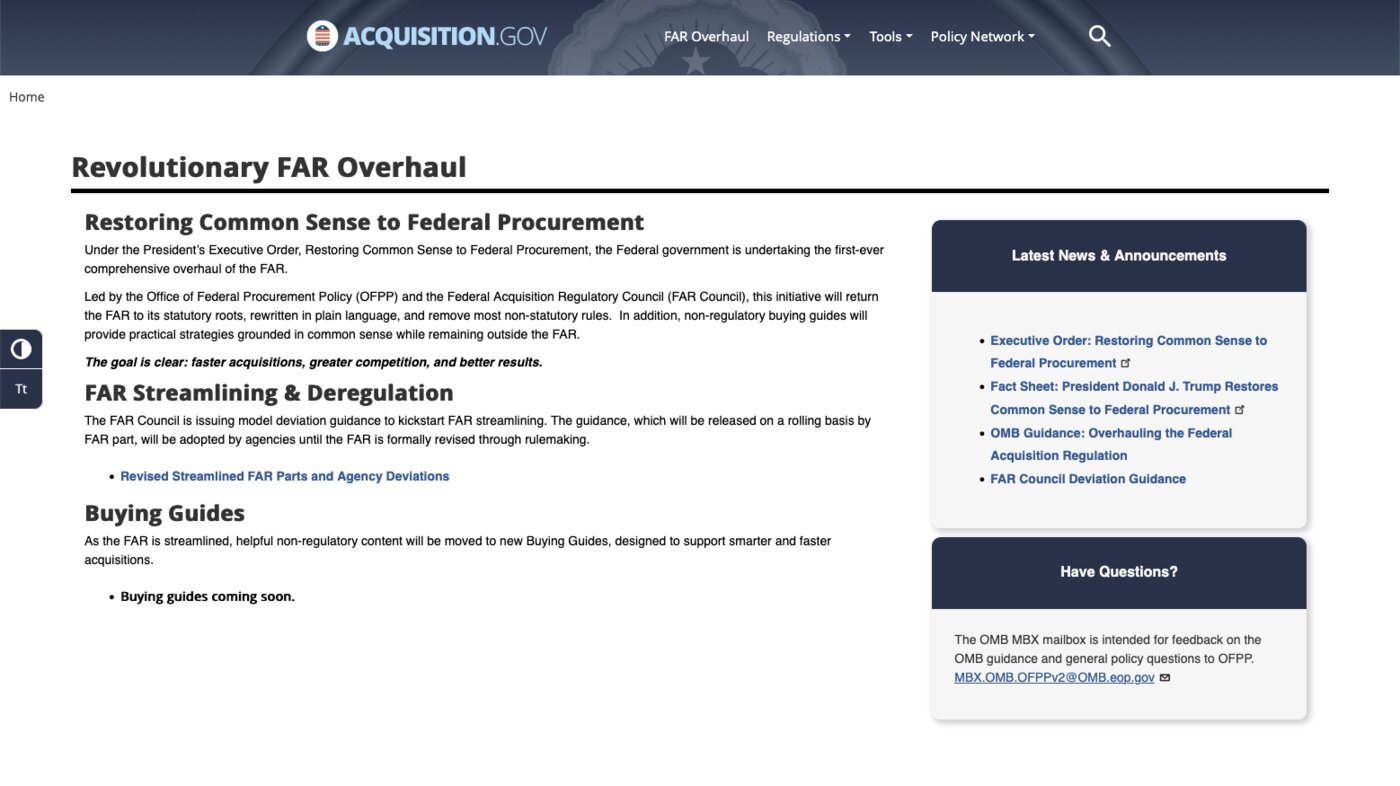Martensen IP Delivers Critical Guidance on the Timeline for Federal Procurement Reform & How Contractors Should Prepare

If you're a federal government contractor or work in government procurement, there's a major shake-up currently upending the procurement process. On April 15, 2025, the White House issued an Executive Order called “Restoring Common Sense to Federal Procurement.” This Order kicks off what the administration is calling a full-blown overhaul of the Federal Acquisition Regulation (FAR). This process could significantly impact how you do business with the federal government contracting system.
The stated goal? To simplify, streamline, and strip down the FAR so that it only includes what’s necessary. If a rule isn’t supported by statute or clearly helps the government buy smarter, faster, or safer, it might be eliminated.
Let’s break down what this means in plain language and what you should watch for.
What the FAR Overhaul 2025 Means for Federal Procurement
In less than a page of text, the Executive Order sets in motion something the White House is calling the “Revolutionary FAR Overhaul,” or RFO. It’s being described as a major rewrite of the procurement rules that govern almost every aspect of how the government buys goods and services.
The Office of Federal Procurement Policy (OFPP) has been tasked with leading this overhaul, and it has broad authority to decide what stays and what goes. Essentially, if a regulation is not mandated by Congress or deemed essential to federal procurement reform, it could be removed.
The stated mission is to create what the Order calls “the most agile, effective, and efficient procurement system possible.” The changes are meant to result in fewer roadblocks, clearer rules, and faster results. However, the implementation of these changes will cause turmoil in the short term, and could have unintended long term consequences.
Timeline for Federal Procurement Reform and Contractor Impact
The pace of the overhaul is set by firm deadlines built into the Executive Order.
- Within 15 days of the Order, federal agencies must send in recommendations about which of their agency-specific rules can be scrapped or updated.
- Within 20 days, the Office of Management and Budget (OMB) must propose new internal rules and issue guidance to help agencies implement the Order.
- Within 180 days, namely by October 15, 2025, the FAR itself is supposed to be formally amended to reflect the changes.
In practice, agencies have struggled to meet the pace mandated in the order. For example, several FAR sections have received a preliminary review, but others are still in progress. Despite this, the order requires that changes recommended in the preliminary review take place immediately, without undergoing the formal rulemaking process.
The preliminary review is supposed to remove all non-statutory regulations, and identify crucial non-statutory regulations that will require Congress to make them statutory. Most non-statutory regulations will be moved into non-binding buying guides.
The potential retention of some regulations based on future Congressional action, and the reliance on non-binding guidance introduces uncertainty about what rules will apply over time, and how different agencies might interpret and apply non-binding rules.
Sunset Provisions in Government Contracting Compliance
Further uncertainty is introduced by the executive order’s policy that some non-statutory rules will be retained with an expiration date.
The Executive Order instructs OFPP and the FAR Council to look at adding sunset provisions—automatic expiration dates—for any rule that isn’t required by law. These rules would have to be actively renewed every four years, or they’d disappear on their own.
This approach adds an ongoing review cycle and discourages regulatory buildup over time. It also means that even if a rule survives now, it may go away at an uncertain point in the future. This presents the real possibility that some rules will sunset during the performance of a contract. What happens if your SBIR data rights become unprotected 2 years into a contract?
How Federal Government Contractors Should Prepare for FAR Changes
So, how do you adapt to this changing landscape if you’re a contractor? Here are four key takeaways to keep in mind:
1. Some Rules Are Here to Stay For Now
Certain non-statutory clauses that benefit the government, like the ability to terminate a contract “for convenience”, are likely safe. These kinds of rules give the government flexibility and are viewed as essential tools, so they’re probably not going anywhere soon. That said, even these might be rewritten in simpler terms.
2. Social Policy Clauses Are on the Chopping Block
The Order suggests that many of the social policy clauses, especially those not backed by law, will be removed. These are often the rules that require contractors to meet certain labor, environmental, or diversity standards. They're typically found in FAR clause 52.212-5 for commercial item contracts and are based more on executive orders and agency preferences than on statutes. As a result, contracting advantages for minority owned businesses will likely go away. However, the Order still expresses support for small businesses.
3. Watch for Interim Rules and Deviations
One of the most immediate impacts for contractors will be the release of class deviations, which are temporary rule changes that affect a wide range of contracts. These might be your first clue that a particular FAR rule is being phased out or changed.
Staying on top of these deviations will help you stay compliant and may even uncover new opportunities as the rules evolve.
4. Your Existing Contracts Still Matter
Even if a clause is removed from the FAR tomorrow, it doesn’t change your current obligations. Contracts already in place will continue to be governed by the terms you agreed to unless the government negotiates a formal change.
Also, deviations and interim rules usually aren’t retroactive. They won’t automatically affect existing contracts unless the government issues a modification. Keep following your contract as written unless told otherwise. The prolonged uncertainty, use of buying guides, and potential sunset of regulations will require contractors to remain vigilant and keep open lines of communication with their contracting officers.
Final Thoughts: Prepare, Don’t Panic
Federal Contracting Compliance in the 2025 FAR Overhaul
The FAR overhaul is big news, and it is moving quickly. But there’s no need to panic. While there will be a great deal of uncertainty, many of the changes will likely be gradual, and some may end up being more about wording and format than substance.
Still, contractors should stay informed and stay flexible. Pay close attention to new memos, class deviations, and proposed rules. Make sure your compliance teams and contract managers know which rules are changing and which ones still apply to your existing contracts.
This could be a unique opportunity for businesses that are ready to adapt quickly. With fewer barriers and simpler rules, navigating federal procurement may become less burdensome, at least in theory.
Just remember: until your contract changes, your obligations do not.
About Martensen IP
At the intersection of business, law and technology, Martensen understands the tools of IP. Martensen knows the business of IP. We understand the tech market, especially when the government is a customer, and we know how to plan, assess, and adjust. Patents, trademarks, copyrights, trade secrets, licenses are our tools.
Martensen IP Media Contact
Mike Martensen | Founder
(719) 358-2254
Source: Prodigy.press
Release ID: 1841163
More News
View More




Recent Quotes
View More
Quotes delayed at least 20 minutes.
By accessing this page, you agree to the Privacy Policy and Terms Of Service.